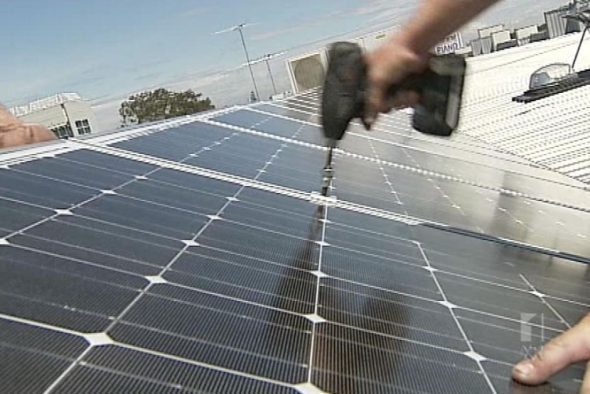The Abbott government’s 2015 Budget has potentially given a major boost to the rooftop solar industry in Australia with the announcement of a $20,000 tax break for small businesses, or “Tony’s Tradies” as the prime minister is calling them.
The deal means that businesses with revenue of less than $2 million a year can buy any machinery or equipment – including solar modules and maybe even battery storage related to their business.
The amount of individual pieces of equipment of up to $20,000 will be 100 per cent tax deductable. The scheme will be in place for another two years
It’s probably the best policy news that the solar industry has received since the election of the Abbott government, given the move by states to reduce feed in tariffs, of pricing regulators to raise fixed charges, and attempts – so far thwarted – by the federal government to cut or phase out the small scale component of the renewable energy target.
“I hope there’ll be lots of small business people thinking now ‘what have I always wanted to buy?” Abbott said in a TV interview on Wednesday.
“Is it a new ute, is it a new bit of equipment, a new fridge or freezer for my shop or restaurant, well you can go out and buy it now and write it off straight away against your tax,” Abbott said.
For many, it could be solar modules, given the ability of solar arrays to reduce and lock in electricity costs.
The sum of $20,000 is enough to buy a solar PV array of around 10kW, possibly more according to some quotes. And/or, it could account for two or three Tesla battery storage devices, or the equivalent from rival manufacturers who now insist they can match Tesla on price.
“Small businesses across Australia can install solar systems, slash their power bills and get an immediate tax write-off of their asset,” said John Grimes, the CEO of the Australian Solar Council. “It is the best use of capital.”
The question for some will be to what extent small business with revenue under $2 million have the roofspace to take advantage of it. It could rule out many manufacturers with larger premises, but Grimes said it could suit businesses such as panel beaters, petrol stations, and small supermarkets.
Ric Brazzale, from Green Energy Trading, says it is a great opportunity for businesses in regional areas, where businesses were more likely to own their own roofspace, and where they pay more for their power.
The tax benefit means that one third of the cost of solar systems will come from the renewable energy market, and another one third from the Tax office – at least for those with a tax bill. “It means that for small businesses, PV is now an even more compelling proposition, given one third of the cost will be recovered from the tax office,” Brazzale said.
The tax benefit is welcome news for the solar industry, given the Coalition government’s announced intention to hold yet another review of the renewable energy target, despite promises not to.
The solar industry says this could put the small scale solar target back on the table, after political pressure forced the government to back off from proposals to slash the small scale target altogether, under pressure from incumbent utilities and fossil fuel generators.
Commercial scale solar – above 10kW – is the fastest growing component of the solar industry in Australia, and promises to be massively disruptive to the incumbent industry.
Bloomberg New Energy Finance on Wednesday says that it will shortly release updated solar forecasts for behind the meter solar generation in Australia.
BNEF Australia head Kobad Bhavnagri said the previous forecast of 18GW of rooftop solar by 2030 (from 4.2GW now) would now be upgraded. He said that between 40-70 per cent of available building stock would have solar within a decade, and all building stock by 2030.
“We will be very surprised if everyone does not have solar in the same way that everyone has a smart phone now,” Bhavnagri said.
This would be massively disruptive. Since 2008, when the solar market started to take off, the value of electricity (the price in the wholesale market) has halved. That’s because of the massive over capacity built – mostly coal and gas, and not renewable – in anticipation of rising demand. But rooftop solar has caused a reduction in demand.
Bhavnagri said he expected the annual installations in rooftop solar to be between 700MW and 1,100MW per year , with commercial solar to be strong and an emerging industrial segment, as large corporates and industrial users moved into the market.
“It is an unstoppable beast,” Bhavnagri said. And it just got another leg up from the government, intentionally or not.









